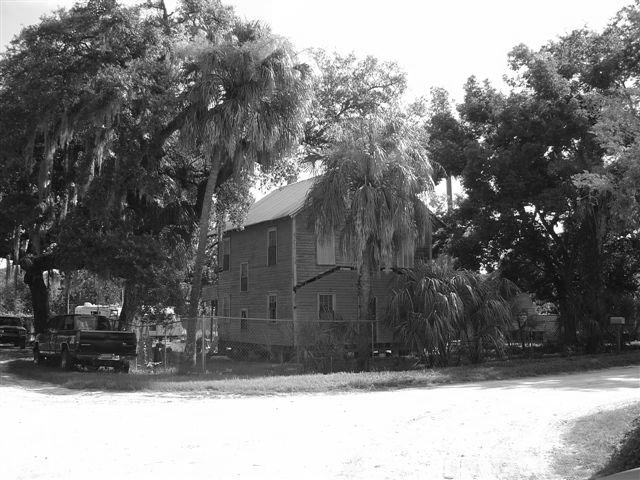HISTORY OF PASCO COUNTY
Lacoochee
Remembering Lacoochee’s Charles P. Thompson Family
 The Thompson house in 2011; courtesy of J. W. Hunnicutt
The Thompson house in 2011; courtesy of J. W. Hunnicutt
By NELL MOODY WOODCOCK
An unsightly two-story building that stands today in what was once
the housing area for employees at the Cummer Sons Cypress Company mill
complex had a gleaming coat of gray paint in the mid-1920s and was the
pride of the Charles P. and Vera Thompson family.
When the Thompsons moved to Lacoochee in 1926 from the sawmill
community of Ehren in another part of Pasco County (see note below),
they brought with them four children: Gene, Carmon, Iris and Garlan.
Four more children, Leland, Norma, Kenneth and Wilma, were born after
they moved here. During World War II when their 23-year-old paratrooper
son Carmon was killed on Luzon in the Philippines, his son, Eddie Carmon
came to live with his grandparents.
When Carmon was called into the Army he was in Bristol, Tenn. in
baseball training with the Indians. Jesse Stanley, who managed the local
baseball teams in Lacoochee, had brought a scout to Lacoochee to watch
this talented left-handed pitcher, and sign him up.
Leland, the first of the Thompson children to be born in Lacoochee,
now lives in Dade City. He was Sheriff of Pasco County from January 1965
until January 1969. He did not seek re-election.
Iris, the Thompson’s third child married Vivian Gaskin who
owned Vivian’s Theatre in Lacoochee. They lived in Dade City until
their deaths. In a 1998 letter Iris recalled:
Mama and Daddy lived in Lacoochee until their deaths, Daddy in 1964
and Mama in 1974. Most of the family worked for Cummer Sons Cypress
Company. I worked in the payoffice for 10 years as payroll clerk and in
The Cummer Ranch office as secretary for J. T. (Bill) McKinstry for 18
years. I retired when the ranch property was sold in 1977. Mr.
McKinstry, Jesse Stanley and I surveyed the property for the Cummer Road
going into Lacoochee .
Goldie Gatlin and I were the first women to work in the Cummer
office. We went to work there in 1942 as the men working in the office
were leaving for the service after the start of World War II in December
of 1941. More women were hired later.
In 1942 there was over 500 people on the payroll. Payday was on
Friday and we paid off with cash money in envelopes. The envelopes had a
slip on the front filled out with the hours each employee worked and
what they owed the company, commissary or the doctor. The slips were
given to each foreman for the employees in his department who in turn
presented them at the pay window to receive their pay.
We had just the right amount of money to put into the pay envelopes,
and if any money was left over after we stuffed them, or we were short
any money, we had to empty and recount each envelope until we found the
mistake. One Friday a man came into the office and said he was short
$20.00 and our boss, Mr. C. F. Andrews, first asked me if we balanced
and when I said yes, he asked the man to search his pockets. He did and
found $20 in his shirt pocket. He said he forgot about putting it there.
Every Friday we had two guards that stayed with us all day. Payday
was a fun day for us.
It was a good company to work for. The pay wasn’t very high but
you always knew you would be paid every week. Depending on the size of
the house, the rent was only $2.50 or $3.00 a week. Your electricity,
garbage pickup and water were free. Later they charged 25-cents or
30-cents a week for electricity, according to the number of rooms.
If you went to the company doctor, Dr. W. H. Walters, a wonderful
man, you paid $2.00 or $3.00 a week on your bill. The nurse, Mrs. Maude
Baxley, came over to the office and I would put the amount owed the
doctor on the payroll and it was taken out of your pay.
When the company turned to Florida Power to furnish the electricity,
it looked like a ghost town at night. But when Cummer furnished it for
free, the whole place was lighted up. The company also made repairs on
the houses, all you had to do was report what you needed done. They kept
a maintenance crew for this.
The first office I worked in was across the road from the commissary
and Dr. Walter’s office in the company quarters. They then built,
in 1961, a nice big office on property east of U.S. Highway 301. When
that office was sold, they built The Cummer Ranch office on their
property east of Dade City. All in all, I worked with them for 28 years.
I would not trade growing up in Lacoochee for anything. The people all
were friendly and if a family needed help, they got it.
My husband, Vivian Gaskins, owned and operated The Vivian Theatre in
Lacoochee from 1924 until we closed it in 1959 when the mill closed.
Every Friday and Saturday night we had a Western picture, a cartoon and
a chapter of a serial. Adults paid 40-cents and kids under 12 paid
9-cents. We had 5-cent and 10-cent bags of popcorn.
Many times on Saturday nights kids were brought to the theatre and
left there, they stayed for the two times we ran the show. When we got
ready to go home about 11 p.m. a kid or two would be waiting for his
parents. We never left them there. We took them home and waited
sometimes as late as 1 o’clock until their parents came home.
Editor’s Note: Years later several central Pasco communities,
including Ehren, Denham and Drexel, were combined to form Land O’
Lakes. |

